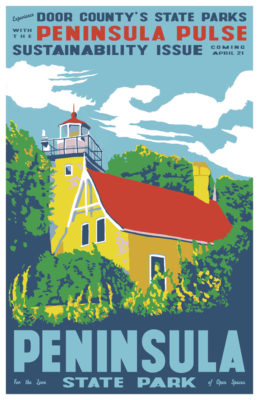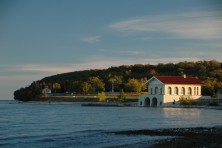Horseshoe Island Adventure
- Share
- Tweet
- Pin
- Share

There’s something about islands that calls to us.
Even when standing on the thin spit of this peninsula, an island in the distance begs us to come, to explore, to wonder, “What’s out there?”
So it is when you’re standing on the shore of Nicolet Bay, looking out toward Horseshoe Island.
“How far is that? Can I swim there?”
For almost all of us, the answer is a resounding no, but we can still go there. The 38.2-acre island is part of Peninsula State Park and easily accessible by a moderately capable kayaker. (You can rent a kayak from the Nicolet Beach Camp Store.) Just keep your eyes peeled for boaters during the one-half-mile paddle through the busy corridor – and wear a life vest.

Paddle into the horseshoe-shaped cove that gives the island its name; pull your kayak ashore; and embark on a one-mile hike around the circumference of the island. It’s not difficult – last summer I reached the island by boat and hiked it with my 2-year-old son and 80-year-old dad, and both completed it without issue.
The trail itself is a beautiful nature walk, with some rocky outcroppings where you can stop to take in the views to the north and west. There’s also history to discover here.
Along the trail near the cove, you’ll find a faded wooden sign pointing to a historical marker. A short hike brings you to a rock, where in 1975, the Ephraim Men’s Club installed a plaque that reads, “A special tribute to the hardy group who as part of the early Moravian Settlers of Ephraim in 1853 died and were buried in this location.”
It is believed to mark the spot where seven people were buried after a cholera outbreak devastated a small group of families that had settled on the island.

You’ll also find old stone steps, which may be remnants of the island estate of Engelmar. In 1888, the wealthy Omaha banker Frank Folda bought the island, and when he died, he left it to his son, Engelbert; and his daughter, Martha.
They eventually built a summer estate called Engelmar (a combination of their first names). By 1912, the lodge and dock were completed, and later, a caretaker’s cottage, ice house and pump house were added.
When the state of Wisconsin established Peninsula State Park in 1909, E.F. (Engelbert) Folda negotiated a selling price of $5,000 and a life estate for himself, his wife and his sister.
But Engelbert’s fortune was one of many lost during the Great Depression, and when he died in 1944, his widow, Alma, relinquished the estate to the park. Remnants of a root cellar, foundation and steps are about all that visitors will find of Engelmar today.
At a Glance
Horseshoe Island Paddle and Hike

Notable: No camping is allowed on Horseshoe Island.
Paddle: One-mile round trip, moderate difficulty. (Wear a life vest and bright colors because there’s a lot of boat traffic in the area.)
Hike: One mile, easy hiking.
Highlights: Rocky outcroppings are a great spot for a snack with a view; a historical marker stands in the spot where early settlers may be buried; see remnants of the Engelmar estate; and get a great view of the Peninsula State Park shore.
Digging Deeper

For a deep dive into the history of Horseshoe Island, find a copy of Stanford H. Sholem’s Horseshoe Island: The Folda Years. This exhaustive history of Frank Folda and his son’s Engelmar estate presents not only a glimpse into one man’s dream, but also how the Depression changed the future of a small island in Peninsula State Park. Get copies by contacting the Eprhaim Historical Foundation at Ephraim.org.





